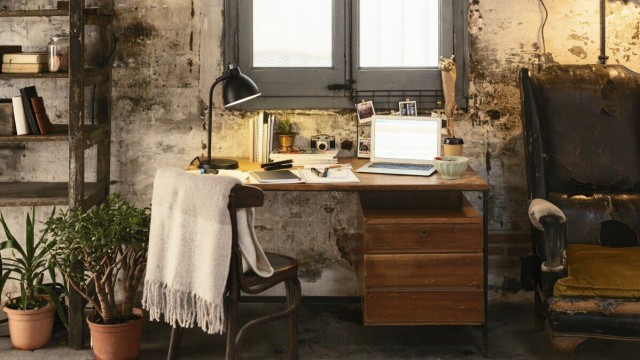
5 Budget Tricks to Upgrade Your Home Learning Space
Learning and working from home continues to be a big part of our lives, and it's worth investing in personal space upgrades to create a conducive environment. Some ways to upgrade your space (without breaking the bank) include adding coloured cushion covers, creating a room divider, and removing clutter.
Where the home was once regarded as a place we sought refuge at the end of each day, it has now taken on a vastly different identity – thanks to remote working and learning arrangements made necessary by our circumstances. Just consider the jump in the number of complaints on renovation noises received during last year’s lockdown, which is hardly surprising as loud exterior noise sources have been shown to elevate psychological distress.
Research has shown that our physical work environment can influence well-being and performance. And with organisations and schools around the world having scrambled to implement remote working and learning arrangements, experts are now studying the psychological effects of staying at home. But besides negative influences that can affect our concentration and efficiency, small lifestyle changes within our control can, conversely, affect our mood and level of happiness. For example, natural elements and sunlight exposure are related positively to job satisfaction and have a calming effect, possibly because we are hardwired by our evolutionary past to feel safer in environments that are rich in resources.
With learning and working from home continuing to be a big part of our lives, it might be worth investing in regular personal space upgrades to create a conducive environment for studying, working and unwinding. And while not every is fortunate enough to work or study to the sounds of a cascading waterfall and views of lush greenery, there are simple décor ideas that can easily be executed without breaking the bank (or relocating to a tropical paradise).
1. Colour therapy
Much more than a hippy-dippy theory inspired by aura readings and chakra healings, colour therapy is rooted in research about how different hues have an effect on mood and can be used to enhance learning. During a 2014 study on “The Effects of Colour on the Moods of College Students”, the responses from students on their moods were collected and analysed based on different spaces in their student union complex. It was determined that shades of green have a relaxing and refreshing effect, while white was monotonous and elicited a sense of boredom.
For those of us who tend to get distracted during Zoom seminars or have trouble concentrating on assigned readings, warm colours such as yellow, red and orange have been found to have a greater effect on attention. The “world’s favourite colour”, on the other hand, is a soothing green or blue — perhaps because they’re associated with natural elements that we enjoy such as water and vegetation.
But instead of undergoing a backbreaking paint job reworking the colour scheme of your room, why not inject pops of colour more economically and easily in the form of fun cushion covers or removable wall decals? Depending on your target mood — that is, to destress or to feel rejuvenated — incorporate the relevant colours into your space for an instant mood reset.
2. Up your room’s hygge factor
Want to know why the home candle business is on fire, with prestige candle sales in the US totalling US$101.9 million in 2018? One reason could be the rise of the hygge trend — a Danish lifestyle movement that evokes a sense of cosiness, often created through the use of scented candles, fuzzy blankets and other feel-good objects of comfort. As Penelope Green, a reporter with The New York Times, wrote in a 2016 article about hygge: “Where Americans see a fire hazard (in candles), the Danes see an antidepressant.”
Not just a clever marketing move by interior designers, making our home learning space more “hygge” can help improve productivity and wellness. Evoke the senses with simple room additions like a scented candle, an ambient sound playlist, and tactile throws and blankets to bring on feel-better vibes. But remember not to go overboard with the feel-good elements: Feeling cosy might be great for unwinding after a long day, but not to the extent that you feel like you need a nap every time a project meeting comes on!
3. Create a room divider
Essential for those sharing a room or wanting to hive off a relaxing nook in which you can unwind from multiple online lessons, a room divider can be easily set up to carve out multi-purpose areas, even in a small space. Use a curtain rod that extends from one wall to another, or simply drape a tapestry from ceiling hooks. Those with a bit more space can use furniture like a bookshelf as a room divider, or create a bed canopy to double up as a mozzie net for resort vibes (and save on air-conditioning bills!).
After which, determine how to do up each space to channel a certain mood. For example, an area with less daylight can be used as a spot for relaxing and sleeping, complete with some tasteful artwork in soothing shades; while the brighter half of the room can be dedicated to work and learning with an inspiration board to stay motivated, indoor plants for oxygenation (which could also increase productivity by 15 per cent) and a clean workspace to boost productivity.
4. Declutter
Research has shown that workspace clutter can impede productivity and well-being, as reams of documents and stationery that are strewn across one’s desk imply having to tackle a huge volume of work at a rapid pace, thereby inducing stress. That is why it pays to channel your inner Marie Kondo and rid your room of clutter, and list unwanted items on Carousell to earn a few bucks while you’re at it.
If you can’t wrap your head around whether a 10-year-old tank top sparks joy, or the thought of throwing things out elicits heart palpitations, start instead with simpler habits like placing a clutter box under a desk or in your wardrobe. Whenever you come across an item or piece of clothing that fit the wrong way, chuck it into the box. At the end of the month, list the items for sale or to give away online, or donate them to a charity.
5. Play with lighting
Besides relying on existing ceiling lights in your room, create other light sources to put you in the mood for study, relaxation or play. Light exposure affects our biological clocks, and the lack of light in temperate regions during the winter months is a cause of Seasonal Affective Disorder (SAD). While it might seem like an affliction unlikely to impact us tropical dwellers, being confined to a space without much natural daylight or ventilation might increase the risk of depression and, at the very least, lower alertness and wakefulness.
Low-energy (and low-fire risk) LED rope lights can be fun additions to your decor scheme, while a smart desk lamp with a changeable colour temperature can also transform your space according to your needs. Blue light emitted from our electronic devices, for example, can lead to higher alertness and performance at work and counteract SAD symptoms— but also strains our retina in the longer term and impedes sleep with overexposure at bedtime. And rather than crowding your study space with coloured items to promote focus or relaxation, a colour-changing light source can be a practical alternative for tweaking your environment throughout the day.




